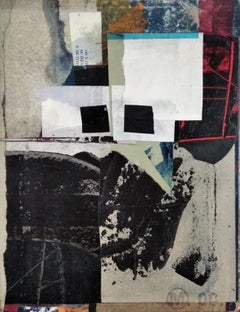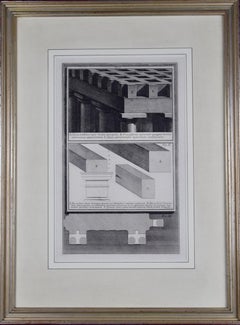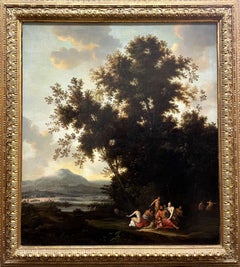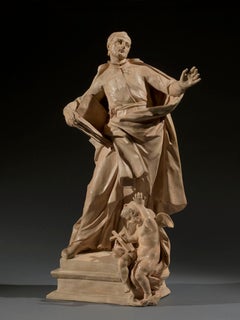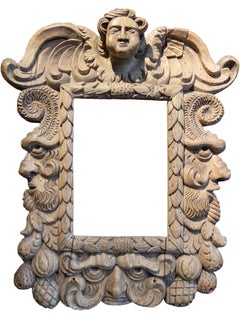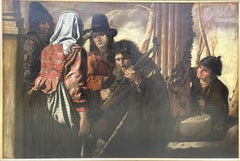18th Century and Earlier Art
to
1,202
4,161
1,483
653
523
727
Overall Width
to
Overall Height
to
7,559
20,973
156,455
235,138
1,865
2,212
4,757
6,452
5,811
13,008
19,549
25,062
17,300
13,338
5,323
3,079
1,241
49
20
14
11
4
3
1
1
1
1
3,656
3,210
388
4,749
2,388
1,576
1,483
1,364
868
680
655
502
442
416
403
327
287
208
193
186
180
176
167
3,579
2,368
1,965
1,097
933
159
127
89
82
79
2,323
3,430
5,005
1,356
Period: 18th Century and Earlier
Untitled
Located in Barcelona, BARCELONA
The painting is being offered with a work and authenticity certificate
Category
Abstract 18th Century and Earlier Art
Materials
Mixed Media
$3,085
18th Century Etching of Ancient Roman Architectural Objects by Giovanni Piranesi
Located in Alamo, CA
A. Tigna Protensa Super Media Epistylia, B. Praecisiones Tigorum Quaqua Versus Extrinsectus Apparentium, C. Opae Extremitates Tigorum Contintes, Fig. I, plate 88 from "Vasi, Candelab...
Category
Old Masters 18th Century and Earlier Art
Materials
Etching
"Satyrs and Nymphs in a Landscape"
By Daniel Vertangen
Located in Edinburgh, GB
Attributed to Daniel Vertangen (1601–1683) – "Satyrs and Nymphs in a Landscape"
Artist: Attributed to Daniel Vertangen (1601–1683)
Title: "Satyrs and Nymphs in a Landscape"
Medium:...
Category
Realist 18th Century and Earlier Art
Materials
Canvas, Oil
Roman 18th century terracotta model for the sculpture of San Camillo de Lellis
Located in London, GB
This remarkably fluid terracotta bozetto was made in preparation for Pietro Pacilli’s most important public commission, a large-scale marble statue of San Camillo de Lellis for the nave of St Peter’s Basilica in Rome. Expressively modelled, this terracotta sculpture is a rare and significant work made by a major Roman sculptor at a transformative moment of European sculpture. Pacilli began his working life on the great Baroque decorative projects initiated in the seventeenth century, but he found success as a restorer of ancient sculpture working to finish antiquities for a tourist market, becoming an important figure in the emergence of an archaeologically minded Neoclassicism. Pacilli trained Vincenzo Pacetti and provided important decorative work for the Museo Pio-Clementino, at the same time he is recorded restoring some of the most celebrated antiquities excavated and exported during the period.
Pacilli was born into a family of Roman craftsmen, his father Carlo was a wood carver, and Pacilli is recorded working with him on the Corsini Chapel in San Giovanni Laternao as early as 1735. In 1738 his terracotta model of Joseph and Potiphar’s Wife won the first prize in the second class of the sculpture concorso at the Accademia di San Luca, this is particularly notable as Bartolomeo Cavaceppi came third. He worked as a carver and stuccoist completing works for the churches of San Marco and SS. Trinita dei Domeniciani Spagnoli. Pacilli operated as a sculptor and restorer of antiquities from his studio at the top of the Spanish Steps, close to Santa Trinita dei Monti, where he is listed as a potential vendor to the Museo Pio-Clementino in 1770.
In 1763 Pacilli completed a silver figure of San Venanzio for the treasury of San Venanzio. He is recorded as Pacetti’s first master and it was evidently through Pacilli that he began to acquire his facility as a restorer of ancient sculpture. Pacilli, at his studio ‘poco prima dell’Arco della Regina alla Trinita dei Monti,’ exercised, what the nineteenth-century scholar, Adolf Michaelis called ‘rejuvenating arts’ on several important pieces of classical sculpture, including in 1760 the group of a Satyr with a Flute for the natural brother of George III, General Wallmoden, Hanovarian minister at Vienna. In 1765, Dallaway and Michaelis record that Pacilli was responsible for the restorations, including the addition of a new head, to the Barberini Venus which he had acquired from Gavin Hamilton. The Venus was then sold to Thomas Jenkins, who in turn passed it on to William Weddell at Newby Hall. In 1767 Pacilli exported a series of ancient busts ‘al naturale’ including portraits of Antinous, Julius Ceaser and Marus Aurelius, also a statue of a Muse and a Venus. As early as 1756 Pacilli seems to have been operating as an antiquarian, helping to disperse the collection of the Villa Borrioni. Pacilli supplied sculpture to notable British collectors, including Charles Townley, who on his first trip to Italy purchased the Palazzo Giustiniani statue of Hecate from Pacilli. Pacilli was involved with the Museo Pio Clementino from its conception, supplying busts of Julius Ceaser and a Roman Woman as well as completing stucco putti surmounting the arms of Pope Bendedict XIV to signal the entrance to the new Museo Critiano.
In 1750 Il Diario Ordinario del Chracas announced that Pacilli had begun work on a sculpture of San Camillo de Lellis for St Peter’s. Camillo de Lellis founded his congregation, the Camillians, with their distinctive red felt crosses stitched on black habits in 1591. Having served as a soldier in the Venetian army, Camillo de Lellis became a novitiate of the Capuchin friars, he moved to Rome and established a religious community for the purpose of caring for the sick. In 1586 Pope Sixtus V formerly recognised the Camillians and assigned them to the Church of Santa Maria Maddalena in Rome. Camillo de Lellis died in 1614 and was entombed at Santa Maria Maddalena, he was canonised by Benedict XIV on June 26, 1746. It was an occasion that prompted the Camillians to make a number of significant artistic commissions, including two canvases by Pierre Subleyras showing episodes from San Camillo’s life which they presented to Benedict XIV. In 1750 Pacilli was commissioned to fill one of the large niches on the north wall of the nave with a sculpture of San Camillo.
The present terracotta bozetto presumably had two important functions, to enable Pacilli to work out his ideas for the finished sculpture and at the same time to show his design to the various commissioning bodies. In this case it would have been Cardinal Alessandro Albani and Monsignor Giovan Francesco Olivieri, the ‘economo’ or treasurer of the fabric of St Peter’s. Previously unrecorded, this terracotta relates to a smaller, less finished model which has recently been identified as being Pacilli’s first idea for his statue of San Camillo. Preserved in Palazzo Venezia, in Rome, the terracotta shows San Camillo with his left hand clutching his vestments to his breast; the pose and action more deliberate and contained than the finished sculpture. In producing the present terracotta Pacilli has expanded and energised the figure. San Camillo is shown with his left hand extended, his head turned to the right, apparently in an attempt to look east down the nave of St Peter’s. The model shows Pacilli experimenting with San Camillo’s costume; prominently on his breast is the red cross of his order, whilst a sense of animation is injected into the figure through the billowing cloak which is pulled across the saint’s projecting right leg. The power of the restrained, axial contrapposto of bent right leg and outstretched left arm, is diminished in the final sculpture where a baroque fussiness is introduced to the drapery. What Pacilli’s terracotta demonstrates, is that he conceived the figure of San Camillo very much in line with the immediate tradition of depicting single figures in St Peter’s; the rhetorical gesture of dynamic saint, arm outstretched, book in hand, head pointed upwards was perhaps borrowed from Camillo Rusconi’s 1733 sculpture of St. Ignatius...
Category
Baroque 18th Century and Earlier Art
Materials
Terracotta
Hand Carved Wooden Frame, 16th Century European School
Located in London, GB
Hand Carved Fruit Wood
Length: 16 inches (40.5 inches)
A striking, richly hand carved frame in high relief. It shows a rich decor of natural organic forms alongside a collection of ...
Category
18th Century and Earlier Art
Materials
Wood
"Gipsy Musicians"
Located in Edinburgh, GB
Kaspar Waldmann (1657–1720) – "Gypsy Musicians"
Medium: Oil on canvas
Dimensions: 100 x 149 cm (unframed), 102 x 151 cm (framed)
Provenance: Private collection
Historical Context &...
Category
Realist 18th Century and Earlier Art
Materials
Canvas, Oil
Follower of Boucher - French 18th Century Oil, Boy Teasing a Girl with a Feather
Located in Corsham, GB
Follower of François Boucher(1703-1770). French School 18th century oil. Boy Teasing a Girl with a Feather. Unsigned. On canvas on stretchers.
Category
18th Century and Earlier Art
Materials
Oil
The Royston Crow (Hooded Crow) /// Thomas Pennant Ornithology Bird Animal Art
By Thomas Pennant
Located in Saint Augustine, FL
Artist: Thomas Pennant (Welsh, 1726-1798)
Title: "The Royston Crow (Hooded Crow)" (Plate D1)
Portfolio: The British Zoology, Class II: Birds
Year: 1761-1766 (First edition)
Medium: O...
Category
Old Masters 18th Century and Earlier Art
Materials
Watercolor, Engraving, Laid Paper
ANCIENT ROMAN RED JASPER APPLIQUE OF TRAGIC ACTOR
Located in Milan, IT
ROMAN RED JASPER APPLIQUE OF TRAGIC ACTOR
Rome, 1st Century A.D.
5.5 x 4.2 cm the mask
2 1/4 x 1 3/4 in
Provenance
Penicuik House, Midlothian, acquired by either Sir John Clerk, 2nd...
Category
18th Century and Earlier Art
Materials
Marble
Ancient Roman Temple - Etching by Nicola Vanni - 18th Century
Located in Roma, IT
Temple from "Antiquities of Herculaneum" is an etching on paper realized by Nicola Vanni in the 18th Century.
Signed on the plate.
Good conditions.
The etching belongs to the prin...
Category
Old Masters 18th Century and Earlier Art
Materials
Etching
The Large Village Fair
Located in Chicago, IL
The Large Village Fair, 1685
Etching
268 x 377 mm.; 10 1/2 x 13 1/4 inches
Watermark:
Arms of Amsterdam
Provenance:
H. Freiherr von und zu Aufsess (Lugt 2749)
M. Menge (Lugt 1893a).
References:
Hollstein 16
Notes:
A fine, early impression (before spots on the sky) of one of Dusart’s most powerful and fanciful works.
Concerning the provenances of this etching:
Hans von und zu Aufsess (1801-1872) was a great book lover and also a major collector of Old Master prints. He was one of the founders, in 1852, of the Germanisches Museum in Nürnberg and was that museum’s director until 1862. Mas Menge (died in 1945) was a famous violinist and also a major collector of Old Master prints and drawings.
Category
Old Masters 18th Century and Earlier Art
Materials
Etching
Maniere de Disposer La Menuiserie, Roubo French cabinetmaking design engraving
Located in Melbourne, Victoria
'Maniere de Disposer La Menuiserie pour Recevoir La Sculpture'
French copper-line engraving by Berthault after Andre Jacob Roubo (1739–1791). 18th century laid watermarked paper.
F...
Category
French School 18th Century and Earlier Art
Materials
Engraving
Nova Iconologia di Cesare Ripa Perugino - illustrated Book - 1618
Located in Roma, IT
Complete title: Nova Iconologia di Cesare Ripa Perugino Cavalier de SS. Maurition & Lazzaro Nella quale si descrivono diverse imagini di Virtu, Vitij, Affetti, Passioni humane, Arti,...
Category
Modern 18th Century and Earlier Art
Materials
Paper
The annunciation to the shepherds 17th Century painting on agate
Located in Milan, IT
THE ANNUNCIATION TO THE SHEPERDS
Italy, 17th Century
Painting on agate in an ebonised wood, gilt bronze and semi-precious stone frame
38 x 31 cm - 15 x 12 1/4 in with frame
14 x 8.5 cm - 5 1/2 x 3 1/4 in without frame
Although quite rare, across the centuries the art of painting on stone...
Category
18th Century and Earlier Art
Materials
Marble
$10,679 Sale Price
25% Off
Newstead in Nottinghamshire. Paul Sandby C18th landscape engraving
By Paul Sandby
Located in Melbourne, Victoria
'Newstead in Nottinghamshire, the Seat of Lord Byron'
Engraving by Thomas Malton after Paul Sandby (1731-1809).
From Paul Sandby's 'The Virtuosi's Museum, Containing Select Views i...
Category
Naturalistic 18th Century and Earlier Art
Materials
Engraving
Ancient Roman Scene - Etching F. Campana - 18th Century
Located in Roma, IT
Ancient Roman Scene from the series "Antiquities of Herculaneum", is an etching on paper realized by Ferdinando Campana in the 18th Century.
Signed on the plate.
Good conditions wi...
Category
Old Masters 18th Century and Earlier Art
Materials
Etching
Amelia Elisabetha, mid 17th century Flemish portrait engraving, 1651
Located in Melbourne, Victoria
Flemish portrait engraving, dated 1651, of Amalie Elisabeth of Hanau-Münzenberg (1602–1651), who was Landgravine consort and Regent of Hesse-Kassel. From a series of portraits of the Dignitaries at the Peace of Münster (Pacis Antesignani sive Icones legatorum).
Lettered in open letters around portraits: 'PVR ET LOYAL'. Lettered in cartouche below portrait: 'Amelia Elisabetha / ... / ... Nomine P.T. Regens.' and "Anselmus van Hulle...
Category
Flemish School 18th Century and Earlier Art
Materials
Engraving
Francesco Casanova (Venetian painter) - 18th century landscape - Battle scene
Located in Varmo, IT
Francesco Casanova (London 1727 – Mödling 1803) attributed to - Battle scene on horseback.
22.5 x 17.5 cm.
Oil on canvas, unframed (not signed).
- Label: “CASANOVA Francesco Giuse...
Category
Rococo 18th Century and Earlier Art
Materials
Canvas, Oil
Triptych Of The Crucifixion, circa 19th Century after PIETRO PERUGINO
Located in Blackwater, GB
Triptych Of The Crucifixion, 19th Century
after PIETRO PERUGINO (1446-1523)
Large circa 19th Century Umbrian School Old Master triptych of the Crucif...
Category
18th Century and Earlier Art
Materials
Canvas, Watercolor
Ancient Roman Architecture: Framed Original 18th C. Etching by G. Piranesi
Located in Alamo, CA
"A sua Eccellenza il Signor Henry Hope Cav. Scozzese Amatore delle Belle Arti from "Vasi, Candelabri, Cippi, Sarcofagi, Tripodi, Lucerne, Ed Ornamenti Antichi", (Vases, candelabra, grave stones, sarcophagi, tripods, lamps, and ancient ornaments) is an etching by Giovanni Battista Piranesi, published in 1778. It depicts stone caryatids...
Category
Old Masters 18th Century and Earlier Art
Materials
Etching
18th C. Portrait of Edward Stanley from Henry VIII's Court after Holbein Drawing
By Hans Holbein
Located in Alamo, CA
This is an 18th century engraved portrait of "Edward Stanley" created by Francesco Bartolozzi (1728–1815), after a drawing by Hans Holbein the Younger (1497- 1543) in the 16th century. Holbein was the official artist in the court of King Henry VIII. Bartolozzi used both etching and stipple engraving techniques to create the work which was published by John Chamberlaine in London in 1793 in "The Book of Imitations of Original Drawings by Hans Holbein in the Collection of His Majesty".
Edward Stanley, 3rd Earl of Derby...
Category
Old Masters 18th Century and Earlier Art
Materials
Engraving, Etching
Elderly Shepherd Leaning on a Staff (after Parmigianino)
Located in Middletown, NY
A lovely chiaroscuro woodcut by Antonio Maria Zanetti the elder after a work by Parmigianino (Girolamo Francesco Maria Mazzola). Printed on cream laid paper, laid down to a cream lai...
Category
Old Masters 18th Century and Earlier Art
Materials
Laid Paper, Woodcut
Portrait of a Lady in a White Dress - 18th Century Watercolour
By John Downman
Located in London, GB
John Downman
1750-1824
Portrait of a Lady in a White Dress
Pencil, stump and watercolour, heightened with white chalk, signed and dated 1784
Imag...
Category
18th Century and Earlier Art
Materials
Watercolor, Paper
Ricinus Africanus Maximus N. 867 J.W. Weinman original engraving 1737
Located in Paonia, CO
Mezzotint Engraving with Some Hand Coloring image size 15.25 x 10 from Johan Wilhelm Weinmann’s ( 1683-1741 ) Phytanthoza Iconographia, a comprehensive scientific eight volume set w...
Category
18th Century and Earlier Art
Materials
Engraving
Hand-Colored Madagascar Parrot Engraving
Located in New York, NY
Original engraving, hand-colored at the time of publication, after the work of George Edwards from "Sammlung verschneider auslandischer und seltener Vogel" by Johann Michael Seligmann. Tab IX. Le Perroquet...
Category
18th Century and Earlier Art
Materials
Laid Paper
"Allegorical Mythological Summer"
Located in Edinburgh, GB
Allegorical Mythological Scene
Unidentified Artist
17th–18th Century
Oil on canvas
Framed: 149 x 196 cm
Canvas: 131 x 180 cm
No signatured
Description
This remarkable Baroque/Roc...
Category
Realist 18th Century and Earlier Art
Materials
Oil, Canvas
17th c. Flemish - Landscape with Flight to Egypt - Antwerp circa 1630
Located in PARIS, FR
LANDSCAPE WITH FLIGHT TO EGYPT,
JASPER VAN DER LANEN (ANTWERP, 1585 - 1634)
17TH CENTURY FLEMISH SCHOOL
ANTWERP CIRCA 1630
Oil on copper, dimensions: h. 10.23 in, w. 14.96 in
Flemish style frame in ebonized wood adorned with wavy moldings and wood veneer.
Framed dimensions: h. 17.32 in, w. 21.65 in
Provenance:
Philips auction...
Category
Old Masters 18th Century and Earlier Art
Materials
Copper
$9,551 Sale Price
30% Off
Christ Crucified Between the Two Thieves
Located in San Francisco, CA
This artwork titled "Christ Crucified Between the Two Thieves" 1653, is an etching on paper After Rembrandt Van Rijn, 1606-1669, plate engraved By French renown engraver Charles Arma...
Category
Realist 18th Century and Earlier Art
Materials
Etching
Carolus de Mallery, by Lucas Vorsetman the Elder after van Dyck
Located in Middletown, NY
An exalted portrait of fellow Flemish engraver and publisher Karel van Mallery.
Lucas Vorsterman the Elder (after Anthony van Dyck).
Carolus de Mallery, from Icones Principum Viror...
Category
Old Masters 18th Century and Earlier Art
Materials
Laid Paper, Engraving, Etching
Two men standing ankle-deep in a body of water, rocky outcrop ... hilltop
Located in Middletown, NY
Etching on light, fibrous, laid Japon paper, 5 3/16 x 6 1/4 inches (132 x 158 mm), full margins. Scattered moderate foxing throughout, very minor printing creases (innate), and one s...
Category
Old Masters 18th Century and Earlier Art
Materials
Handmade Paper, Etching
"A shepherd teaching a shepherdess to play the flute"
Located in Edinburgh, GB
Unknown artist, copy François Boucher (1703–1770)
"A Shepherd Teaching a Shepherdess to Play the Flute"
Medium: Oil on canvas
Dimensions (Framed): 115 x 100 cm
Dimensions (Canvas): ...
Category
Realist 18th Century and Earlier Art
Materials
Oil, Canvas
Venetian School: Neoclassical banquet scene with angels and putti.
Located in Middletown, NY
Brownish black ink on dark cream, handmade, laid paper, 8 1/4 x 10 1/4 inches (208 x 260 mm). Uniform age tone with several scattered, unobtrusive spots of brown discoloration, consistent with age. Right top corner loss, evenly trimmed, paper tape remnants at top left corner, recto. Collector's stamp in blue ink ("PRB"), lower left corner, recto. On the verso is a neoclassical graphite and brown ink study of a procession showing a woman being carried in a birthing sedan chair. The woman is being carried backwards, with putti, and horn players, leading her up an embankment, across a river. In her wake we see a crowned man...
Category
Old Masters 18th Century and Earlier Art
Materials
Handmade Paper, Ink, Laid Paper
Saint Simon, from Christ and the Apostles
By Ludolf Ludwig Businck
Located in Middletown, NY
Chiaroscuro woodcut on cream laid paper, printed from three blocks in black, olive-green, and yellow ochre, 8 3/16 x 6 1/4 inches (207 x 157 mm), thread margins. Some scattered light discoloration throughout, lightly backed with laid paper, however the sheet retains translucence when viewed through raking light. Trimmed at or near the margin. Archivally sound small repaired corner tear, upper right, with a very minor (1/4 inch) vertical edge split in the center top margin, above the figure's head. All condition issues are consistent with age, and present an exceptionally good example of this truly remarkable work. With the collector's stamp of Friedrich August II, King of Saxony, last King of Poland (1797-1854), Dresden, on the right corner, recto (Lugt 971). This work likely appeared in a well-known posthumous sale of Friedrich August II's private collection, which was handled by C.G. Boerner, and took place in Leipzig, on May 7-9, 1928, presumably this print was presented as lot 1551.
[Stechow 16]
Ludolph Busïnck was born at Hann, Germany around 1590. By about 1620 he was actively working as a printmaker in Paris, collaborating with publisher and celebrated cartographer Melchoir Tavernier. Busïnck may have studied printmaking in the Netherlands, evidenced by the influence of Dutch printmaker Hendrick Goltzius we see in the bold woodcuts he produced in France. Busïnck was the first printmaker to create chiaroscuro woodcuts in France, a technique originated by German artist Hans Burgkmair...
Category
Old Masters 18th Century and Earlier Art
Materials
Woodcut
The Great Landscapes II, (4th State)
Located in Chicago, IL
Watermark:
Schellenkappe (Foolscap) Similar to Churchill no. 340
Category
Old Masters 18th Century and Earlier Art
Materials
Etching
17Th Century Animals Scene Angelo Maria Crivelli Fight Fox Oil on Canvas Orange
By Angelo Maria Crivelli
Located in Sanremo, IT
This fox in the chicken coop, oil on canvas, 105 x 156 without frame and 135 x 185 cm with frame, was clearly painted by Angelo Maria Crivelli (Milan 1660 - 1730) called Crivellone; painter from the Milanese stable but also very active in Piedmont thanks to the Savoy family.
The theme in question was very successful in his time and he also developed it vertically, as we can see in some of his works at Castello Sforzesco; here the defense of the hen house...
Category
Italian School 18th Century and Earlier Art
Materials
Canvas, Oil
Mid-17th-Century Neapolitan School, Still Life With Grapes, Peaches & Plums
Located in Cheltenham, GB
This elaborate mid-17th-century Neapolitan school still life depicts a pyramidal arrangement of fruit on a circular silver platter. It’s somewhat reminiscent of works by Luca Forte (...
Category
Italian School 18th Century and Earlier Art
Materials
Oil, Canvas
Putto in legno dorato reggi candela barocco italiano
Located in Florence, IT
One flame candle holder putto made of gilded wood.
Those kind of objects were present in churches or noble villas, specially during the Baroque times.
The base is not coeval.
Category
Baroque 18th Century and Earlier Art
Materials
Gold
The Three Magi
Located in New York, NY
Provenance: Private Collection, Spain.
Known as Peruvian alabaster for its translucency and workability, Piedra de Huamanga is a highly prized material from the province of Ayacucho in Peru. In the 17th and 18th centuries, local craftsman in the town of Huamanga began to specialize in the production of small-scale, polychrome religious sculptures made from this distinctive stone. Huamanga sculptures are among the most accomplished examples of carving from the Spanish Americas, where polychrome wood sculpture was a far more common sculptural medium. These works, which were created as independent sculptures or as sculptural groups—such as our three Magi—were intended for ecclesiastical as well as domestics settings.
Our three figures likely formed part of a larger Nativity group—a New World variant of the tradition of the Neapolitan Crèche...
Category
18th Century and Earlier Art
Materials
Alabaster
Les Bergers Romains, landscape with Roman ruins, 18th century engraving
Located in Melbourne, Victoria
Les Bergers Romains
Copper-line engraving by Jean Jacques Leveau (1729-1786) after Pierre Mettay (1728-1759). C1755.
Proof, before lettering. Laid, watermarked paper.
A landscap...
Category
French School 18th Century and Earlier Art
Materials
Engraving
La cuisinière écaillant le poisson dans une cuisine
Located in ROUEN, FR
VAN GRIEF Adrien dit GRIFF. (1670-1715). « La cuisinière écaillant le poisson dans une cuisine avec une très jolie nature morte au gibier, légumes et chiens ». Huile sur toile signée...
Category
French School 18th Century and Earlier Art
Materials
Oil
"Winter Landscape"
Located in Edinburgh, GB
Isaac van Ostade (1621-1649) – "Winter Landscape"
An exquisite 17th-century Dutch Golden Age winter scene by Isaac van Ostade (1621-1649), a master of genre painting renowned for his...
Category
18th Century and Earlier Art
Materials
Oil, Canvas
Anthony Friedkin, Rick Dano, Malibu, Surfer, Smoking, Car, June Gloom, B&W
Located in Zurich, CH
Anthony FRIEDKIN (*1949, America)
Clockwork Malibu, Rick Dano on P.C.H., Malibu, California, U.S.A., 1977
Silver Gelatin Print, later print
40.6 x 50.8 cm (16 x 20 in.)
Edition of 25...
Category
Contemporary 18th Century and Earlier Art
Materials
Silver Gelatin
Old Church - Original Etching by F.E. Weirotter - Half of 1700
Located in Roma, IT
Old Church is an original artwork realized by Franz Edmund Weirotter in the first half of the XVIII Century.
Original Etching on paper. Passepartout included (cm 37 x 55).
Signed...
Category
Modern 18th Century and Earlier Art
Materials
Etching
Late 18th – early 19th century landscape with two young girls, and goat
Located in San Francisco, CA
Late 18th – early 19th century landscape with two young girls, and goat. Signed allegedly low capital R. T. Relined/restored. Oil on canvas. 12.75 x 16.
Category
18th Century and Earlier Art
Materials
Canvas, Oil
A late 17th Italian carved limewood figure of Mermaid, circle of Filippo Parodi
Located in PARIS, FR
A late 17th c. Italian carved figure of Mermaid,
Circle of Filippo Parodi (Genoa, 1630 – July 22, 1702)
Dimensions: h. 29.13 in, w. 30.31 in, p. 18.9 in (at the base)
Magnificent Italian Baroque sculpture depicting a mermaid seated on the rock.
All the virtuosity of the sculptor unfolds in this carved group. The fantastic creature is featured seated, the upper part of the body darting forward, the head looking upwards. Sophisticated hairstyle with rows of pearls intertwined in her hair, her loose locks fly in the wind and bring movement to the whole sculpture.
The wide-open eyes with hollowed-out pupils make it possible to follow the mermaid's gaze, towards the sky. The half-open mouth further magnifies this bewitching and seductive attitude.
Its long double tail ending in fins wraps on either side of a rocky mound strewn with objects evoking the underwater world: seashells and shells, branches of coral.
The ornamental richness combined with the great care taken in its execution make it a work in which the splendor of Italian Baroque art unfolds in such characteristic scenic movement.
The composition betrays a strong influence from Filippo Parodi, the leader of Genoese Baroque sculpture, and points to an artist from his circle.
Our sculpture was probably part of a decorative monumental palace.
The iconographic theme evoking the marine world finds its application in the numerous fountains and artificial grottos, designed in Italian palaces at the turn of the 17th and 18th centuries.
Giacomo Filippo Parodi (Genoa 1630 – July 22, 1702) was an Italian Baroque sculptor of the Genoese school, who introduced Bernini's aesthetic to Genoa.
In his youth fathers a first apprenticeship with a carpenter, he went to Rome where he became a pupil of Bernini.
He had the opportunity to admire in person the works and style of the French sculptor Pierre Puget...
Category
Baroque 18th Century and Earlier Art
Materials
Wood
$20,883 Sale Price
20% Off
The Matchmaker, oil on canvas by Jan Baptist Lambrechts
Located in Gent, VOV
Jan Baptist LAMBRECHTS (Antwerp, 1680 - after 1731), L'entremetteuse Canvas. On verso, wax stamp. 40 x 31 cm Expert : M. René MILLET
Lambrechts was born in Antwerp in 1680. His fathe...
Category
18th Century and Earlier Art
Materials
Canvas, Oil
The Battle Of Sluys (1340), oil on canvas, 100 Hundred Years War Naval Scene
Located in Blackwater, GB
The Battle Of Sluys (1340), oil on canvas, 16th/17th Century
Rare account of the opening engagement of The Hundred Years War (1337-1453)
Fine huge antique history painting depictin...
Category
18th Century and Earlier Art
Materials
Canvas, Oil
A Night Dance by Women in Tonga: Original 18th C. Engraving, Cook's 3rd Voyage
By John Webber
Located in Alamo, CA
"A Night Dance by Women in Hapaee" is an original 18th century engraving from a drawing by John Webber (1751-1793), who was the artist who accompanied Captain Cook on his third voyag...
Category
18th Century and Earlier Art
Materials
Engraving
Correciòn - Etching by Francisco Goya - 1799
Located in Roma, IT
Correcion from Los Caprichos is an original artwork realized by the artist Francisco Goya and published for the first time in 1799.
Etching and aquatint on paper.
The etching is pa...
Category
Modern 18th Century and Earlier Art
Materials
Etching, Aquatint
Ancient Views of Paris - Etching - 1748
Located in Roma, IT
4 Etchings on paper realized in 1748. Each cm. 17x22.
Very good condition except for some minor foxing.
Includes a wooden frame cm. 27.5x41.5
Category
Modern 18th Century and Earlier Art
Materials
Etching
Peasants Playing Bowls Outside an Inn, 17th Century Oil on Oak Old Master
Located in London, GB
Studio of David Teniers the Younger
1610 - 1690
Peasants Playing Bowls Outside an Inn
Oil on oak cradled panel, signed
Image size: 16 ½ x 22 ½ inches
Gilt s...
Category
Old Masters 18th Century and Earlier Art
Materials
Oil
In The Hall - Etching by Pierre-Edmé Babel - 1771
Located in Roma, IT
In The Hall is an etching realized in 1771 by Pierre-Edmé Babel.
Titled and Signed on the plate.
The artwork is depicted through confident strokes in a well balanced composition.
...
Category
Modern 18th Century and Earlier Art
Materials
Etching
Mercurio / Mercury
Located in Middletown, NY
A lovely, early drawing of the Roman god Mercury.
Pen and brown ink on cream laid paper, with a partial crown and shield watermark, 7 1/4 x 4 7/8 inches (184x 123 mm) (matrix). In go...
Category
Old Masters 18th Century and Earlier Art
Materials
Ink, Handmade Paper, Laid Paper
Benjamin West, history painter, portrait, soft ground etching, 1809
Located in Melbourne, Victoria
'Benj. West RA'
Soft ground etching by William Daniell RA (1769-1837) after George Dance the Younger (1741-1825), 1809.
Benjamin West PRA (1738 – 1820) was an Anglo-American painter of historical scenes around and after the time of the American War of Independence...
Category
English School 18th Century and Earlier Art
Materials
Engraving, Etching
"Inside of a House in Nootka Sound" (Canada) from Captain Cook's 3rd Voyage
By John Webber
Located in Alamo, CA
"The Inside of a House in Nootka Sound" is an engraving created by William Sharp (1749-1824), from a drawing by John Webber (1752-1793), who was the artist on Captain James Cook's 3rd and final voyage of discovery. It is Plate 65 in "A Voyage to the Pacific Ocean Undertaken by the Command of His Majesty, for Making Discoveries in the Northern Hemisphere", the official British Admirality sanctioned journal published upon completion of the voyage in London in 1784 by Strahan & Cadell.
This engraving is presented in a Koa wood frame and a white mat. There are occasional tiny faint spots, but the print is otherwise in very good condition. Koa wood is legendary in Hawaii. Not only is this amazing wood native to Hawaii, but it is known for the deep rich colors and varied grain pattern. Koa has an honored heritage in Hawaii and is highly revered and sacred. The word “koa” means “warrior” in Hawaiian. The warriors of King Kamehameha the Great, created canoes and weapons from a wood plentiful on the Big Island of Hawaii. This wood became synonymous with the warriors themselves, and it became known as koa.
There are three other engravings listed form the official journal of Captain Cook's 3rd voyage available that are presented in identical Koa wood frames and mats. They would make a wonderful grouping for a display of 2, 3 or 4 prints. Please see listings: LU117324682432, LU117324684022, LU117324684062. A discount is available for a grouping depending on the number of items included.
Nootka Sound is on the west coast of Vancouver Island, British Columbia, Canada. It was explored by Captain Cook in 1778 after he discovered Hawaii during his 3rd voyage. He originally named it King George's Sound, but did record Nootka Sound, which he thought was its native name. Hawaii was originally called The Sandwich Islands in honor of The Earl of...
Category
Realist 18th Century and Earlier Art
Materials
Engraving
Landscape with waterfall, Dutch School 17th century
Located in GB
This dramatic landscape, attributed to the 17th-century Dutch School, exemplifies the Baroque fascination with nature’s grandeur and theatrical contrasts. The composition features a ...
Category
18th Century and Earlier Art
Materials
Canvas, Oil
George Edwards: 18th Century Engravings of Ducks And Wading Birds
Located in Richmond, GB
George Edwards: ""A History of Uncommon Birds"", 1749-1761.
A prominent English naturalist and ornithologist, George Edwards (1694 -1773) is best known for his work, ""A Natural His...
Category
18th Century and Earlier Art
Materials
Watercolor
George Edwards: 18th Century Engravings of Ducks And Wading Birds
Located in Richmond, GB
George Edwards: ""A History of Uncommon Birds"", 1749-1761.
A prominent English naturalist and ornithologist, George Edwards (1694 -1773) is best known for his work, ""A Natural His...
Category
18th Century and Earlier Art
Materials
Watercolor
George Edwards: 18th Century Engravings of Ducks And Wading Birds
Located in Richmond, GB
George Edwards: ""A History of Uncommon Birds"", 1749-1761.
A prominent English naturalist and ornithologist, George Edwards (1694 -1773) is best known for his work, ""A Natural His...
Category
18th Century and Earlier Art
Materials
Watercolor
Seaman in petticoat breeches and slops, smoking a pipe, carrying a carpetbag.
Located in Middletown, NY
English School, 18th century
Pen and black ink with gray wash on cream laid paper, 9 1/4 x 5 inches (238 x132 mm). 1/4 inch repaired loss, top center, to the left of the figure’s h...
Category
Realist 18th Century and Earlier Art
Materials
Ink, Watercolor, Laid Paper, Pen
